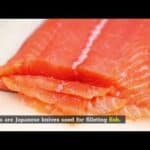Deba Knife or Deba Bocho is a much more traditional Japanese filleting knife than western-style Japanese filleting knives.
In addition to beheading and filleting fish, the Deba knife is also designed for chopping vegetables and fruit. This fish beheader has a sharp blade and weighs slightly more than its smaller counterpart. By using the curvature and bevel of the knife, you can easily separate the filler from the bones when filleting the fish. Looking for best Japanese Knives? We have a list of review you can check.
Japanese Fillet Knives: What Are They
Deba are Japanese fillet knives with a single beveled edge sharpened on one side at various angles, depending on how you plan to use them. These devices are specifically designed to separate the flesh of the fish from its bones and skin.
The blades of conventional fillet knives are made of carbon steel, which needs constant lubrication and maintenance to prevent rusting. Modern fillet knives are made of stainless steel, and they are easier to maintain.
The blades usually measure between 150 mm and 280 mm. Your fillet will have a different consistency and texture due to these differences.
Stainless steel knives are perfect for preparing fish meal as they are created by blacksmiths in Japan. As a result of their perfect angulation, the blades are sharp, allowing you to make accurate fillet cuts every time. You’ll find different designs with their unique characteristics such as the shape of the blade, the thickness, flexibility, and grind.
Deba Knife Vs Fillet Knife
With its wider width and lower flexibility, the Deba Knife is more versatile than traditional knives. It can be used both for beheading and filleting fish, so you can complete the filleting process faster from beginning to end.
In contrast, when filleting large fish, the Deba knife lacks the length and flexibility to maneuver as quickly as other boning knife-style Japanese fillet knives. The blade is also not as thin, which makes it a little harder to make precise cuts.
Filleting fish with a standard style fillet knife is more efficient, elegant, and effective than using a Deba knife. Nevertheless, there are certain factors to consider regarding the type and size of fish you are filleting. Larger fish may even require a longer knife than a boning knife or Deba knife, which is when a Yanagiba comes in handy.
Flexibility
Knives with traditional designs are more likely to have stiff blades. Cutting most meats with this is great, but removing meat from delicate fish bones is not ideal. Choosing the best Japanese knife for filleting fish requires a thin, flexible blade that will slide under the meat and bend slightly to help you make a precise cut. A high-quality Japanese fillet knife should glide effortlessly through the meat as it separates it from the bone, as opposed to a standard knife, which can get caught in the meat.
Blade Length
Having multiple Japanese filleting knives in your arsenal might come in handy if you plan on cooking a lot of fish. Naturally, a large knife is ideal for larger fish. In general, a knife with a short blade makes life much easier when you are cutting small fish. To ensure that you are using a knife that matches the fish’s length, use one half an inch longer than it is.
Handle
Japanese filleting knives are among the sharpest in the tool shed. In addition, they usually do not have a full bolster, which would keep your fingers much safer. Make sure to check the knife’s handle, particularly when shopping online, since it’s critical to find one with a good grip and a sturdy no-slip handle.
Single vs. Double Bevel
A single bevel or double bevel refers to a knife’s blade having a one-sided or two-sided angle toward the edge. Single bevels work best for filleting most fish, since they allow for more precise cutting. When filleting fish, you can lay the edge of the knife flat and make a clean horizontal cut to get the fillet.
Double bevel knives are more general purpose and do not make precise cuts as well as single bevel knives. This isn’t always an issue, and depending on how precise you want your fish fillets to be, a double-bevel knife will do, but a single-bevel knife will give you more precision.
Was this helpful?
Hi there! I’m a food enthusiast and journalist, and I have a real passion for food that goes beyond the kitchen. I love my dream job and I’m lucky enough to be able to share my knowledge with readers of several large media outlets. My specialty is writing engaging food-related content, and I take pride in being able to connect with my audience. I’m known for my creativity in the kitchen, and I’m confident that I can be the perfect guide for anyone looking to take their culinary journey to the next level.








